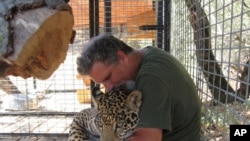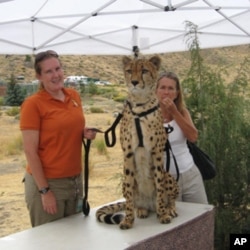Dale Anderson’s love affair with big cats goes back to junior high school in Santa Rosa, California, when a mountain lion cub was brought to his seventh grade classroom.
“And ever since then I’ve had a desire to do something with cats," he says. "I don’t know why. Maybe it was God-given in some ways because I don’t explain it any other way.”
In his early thirties, after working for two years at an exotic cat breeding center and several years of visiting big cat sanctuaries around the world, Anderson felt qualified to launch his own grassroots conservation project. Today, at 51, his property in the foothills of California’s Sierra Nevada Mountains is home to 27 wild cats - big and small.
“This is not a traditional job," he says. "I can blaze my own trail because there’s not anything out there saying this is how you get there.”
Animal ambassadors
It began in 1992, when Anderson bought 37 hectares of California woodland, with dense stands of hardy shrubs and natural springs, and began seeking permits to own exotic and endangered wild animals.
Six years later, he opened Cat Haven, which is now home to eleven cat species, including lions, tigers, several types of leopards, cheetahs, jaguars, jaguarundis, bobcats, lynx and an African serval.
Anderson sees his animals as ambassadors for all wild cats. He believes if people can see them up close and in person at Cat Haven, they’ll fall in love as he did, and be inspired to take action to help them. Anderson launched Project Survival to coordinate that aid.
“The objective is to get the message across and then channel the money away from here to projects that need to get done," he says. "What I want to do is make it so when people come up here they walk away and go, ‘Jeez, I want to help in conservation. I want to do something to help save animals in the wild and I have a way to be able to do that. I can work through Project Survival to make that happen.’"
The animals at Cat Haven are caged, but have lots of space to roam and exercise. Each enclosure is tailored to the needs of the cat.
Leopards like to climb, so their tall cages are built around trees. Lions have large open areas with fenced runs. There's a pond in the tigers’ enclosure, since they are one of the few cats which like water.
All have shelter from the elements. Anderson says his cats are happy in their homes. If they weren’t, he adds, they’d show it.
When Anderson walks into one of his big cats’ compounds, they greet him by jumping up, and putting their paws on his shoulders. When he sits down, they try to crawl in his lap.
Anderson reflects on recent publicity surrounding an Ohio man who released 56 exotic animals - including lions, tigers and bears - which he had kept in captivity. Authorities shot and killed 48 of the animals.
"It's a sad situation for all parties involved. Obviously, the cats and bears had to be killed but it's unfortunate," he says. "I look at this as an oddball situation which doesn't have any bearing in the sense of the bigger pictures of animals in captivity. It's a weird thing. People should not use this to make a statement that people shouldn't have exotic animals."
Show time
Some of Anderson's cats, which were born in captivity, go out with him for publicity, education and fundraising.
Anderson had his five-year-old cheetah, Tango, with him, at a recent joint fundraiser for Cat Haven and the Animal Ark wildlife sanctuary and bear rehabilitation center near Reno, Nevada. Tango has also appeared in a number of TV commercials.
“Usually when he goes out and does a shoot, it usually ends being about $7,000 or $8,000 for a day," Anderson says. "He’s recognized around as probably one of the best working cheetahs to come out and do public things like this because he is really good.”
It costs about $225,000 a year to operate Cat Haven. Anderson donates any money beyond that to wild cat conservancies around the world, including $20,000 to Rebecca Klein's Cheetah Conservation Botswana. The group works to reduce conflicts over grasslands used by both ranchers and cheetahs. Klein calls Anderson a fantastic person.
“I don’t really agree with having healthy animals in cages, but I think it’s really important what he does in utilizing the presence of those animals to raise awareness for their conservation to inspire people about these incredible species, and, also, to raise funds for in-the-field projects such as Cheetah Conservation Botswana," Klein says. "And I think he’s a very passionate, energetic, inspiring person that definitely encourages people to take action.”
Spreading the word
While he feels he is helping make positive changes in the wild cat world, Anderson says there is still much work to be done.
Keeping in mind how he reacted to a big cat as a small boy, he and Tango visit about 50 schools each year and he often welcomes groups of schoolchildren to Cat Haven.
“I look for the next Dale to come up behind me. You know, I go out and do school programs, do things like that, I’m hoping, ‘Jeez, maybe we’re inspiring the next group of people that’s going to come up and actually effect more change than what we’ve done.’ It’s a legacy thing," he says. "Let’s make sure the cats continue to be in the wild and people can still see them for generations to come.”











